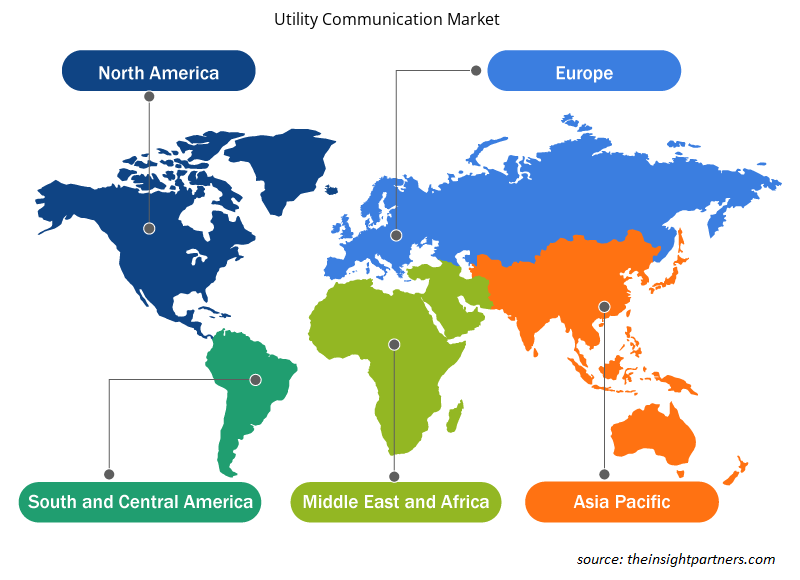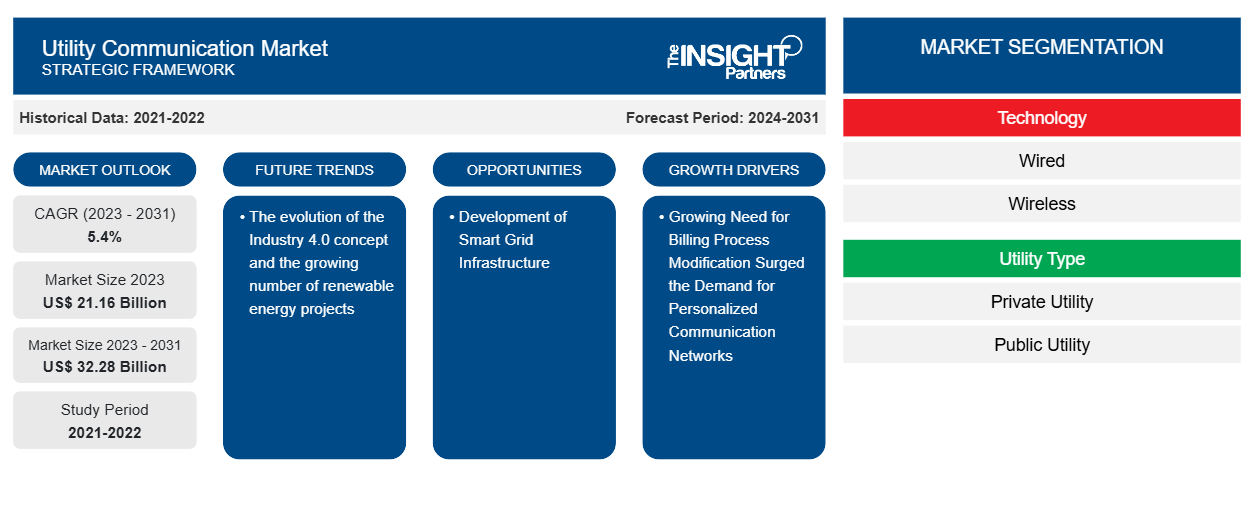Le marché des communications des services publics devrait atteindre 32,28 milliards de dollars d'ici 2031, contre 21,16 milliards de dollars en 2023. Le marché devrait enregistrer un TCAC de 5,4 % entre 2023 et 2031. L'évolution du concept Industrie 4.0 et le nombre croissant de projets d'énergie renouvelable devraient rester des tendances clés du marché des communications des services publics.
Analyse du marché des communications utilitaires
Le marché des communications des services publics connaît une croissance rapide en raison du besoin croissant de modification du processus de facturation, de la demande croissante de réseaux de communication personnalisés et de la demande croissante de ressources énergétiques distribuées (DER). Le marché est en constante expansion, stimulé par des initiatives gouvernementales favorables et des investissements visant à promouvoir le développement des infrastructures électriques. De plus, le développement des infrastructures de réseau intelligent et l'adoption croissante de systèmes technologiquement avancés intégrés à l'Internet des objets (IoT) et à l'intelligence artificielle (IA) offrent des opportunités lucratives de croissance du marché.
Aperçu du marché des communications utilitaires
Les systèmes de communication des services publics assurent une transmission plus fiable, plus sûre et plus sécurisée des données, de la vidéo et de la voix sur les réseaux WAN et LAN. Ce système de communication offre aux utilisateurs les avantages d'une installation facile dans des endroits dangereux. Le système de communication des services publics fonctionne en utilisant de nombreux réseaux, notamment la vidéosurveillance, le réseau intelligent, le système de contrôle de supervision et d'acquisition de données (SADA) et la connectivité Ethernet. De plus, la demande croissante de systèmes de communication filaires et sans fil par les services publics pour surveiller la consommation et la distribution d'énergie stimule le marché au cours de la période de prévision.
Personnalisez ce rapport en fonction de vos besoins
Vous bénéficierez d'une personnalisation gratuite de n'importe quel rapport, y compris de certaines parties de ce rapport, d'une analyse au niveau des pays, d'un pack de données Excel, ainsi que de superbes offres et réductions pour les start-ups et les universités.
- Obtenez les principales tendances clés du marché de ce rapport.Cet échantillon GRATUIT comprendra une analyse de données, allant des tendances du marché aux estimations et prévisions.
Aperçu régional du marché des communications utilitaires
Les tendances et facteurs régionaux influençant le marché des communications utilitaires tout au long de la période de prévision ont été expliqués en détail par les analystes d'Insight Partners. Cette section traite également des segments et de la géographie du marché des communications utilitaires en Amérique du Nord, en Europe, en Asie-Pacifique, au Moyen-Orient et en Afrique, ainsi qu'en Amérique du Sud et en Amérique centrale.

- Obtenez les données régionales spécifiques au marché des communications utilitaires
Portée du rapport sur le marché des communications utilitaires
| Attribut de rapport | Détails |
|---|---|
| Taille du marché en 2023 | 21,16 milliards de dollars américains |
| Taille du marché d'ici 2031 | 32,28 milliards de dollars américains |
| Taux de croissance annuel composé mondial (2023-2031) | 5,4% |
| Données historiques | 2021-2022 |
| Période de prévision | 2024-2031 |
| Segments couverts | Par technologie
|
| Régions et pays couverts | Amérique du Nord
|
| Leaders du marché et profils d'entreprises clés |
|
Densité des acteurs du marché : comprendre son impact sur la dynamique des entreprises
Le marché des communications utilitaires connaît une croissance rapide, tirée par la demande croissante des utilisateurs finaux en raison de facteurs tels que l'évolution des préférences des consommateurs, les avancées technologiques et une plus grande sensibilisation aux avantages du produit. À mesure que la demande augmente, les entreprises élargissent leurs offres, innovent pour répondre aux besoins des consommateurs et capitalisent sur les tendances émergentes, ce qui alimente davantage la croissance du marché.
La densité des acteurs du marché fait référence à la répartition des entreprises ou des sociétés opérant sur un marché ou un secteur particulier. Elle indique le nombre de concurrents (acteurs du marché) présents sur un marché donné par rapport à sa taille ou à sa valeur marchande totale.
Les principales entreprises opérant sur le marché des communications utilitaires sont :
- ABB Ltée
- FUJITSU LIMITÉE
- Compagnie Générale d'Électricité
- Honeywell International Inc
- OMICRON Electronics GmbH
- Rockwell Automation
Avis de non-responsabilité : les sociétés répertoriées ci-dessus ne sont pas classées dans un ordre particulier.

- Obtenez un aperçu des principaux acteurs du marché des communications utilitaires
- Analyse historique (2 ans), année de base, prévision (7 ans) avec TCAC
- Analyse PEST et SWOT
- Taille du marché Valeur / Volume - Mondial, Régional, Pays
- Industrie et paysage concurrentiel
- Ensemble de données Excel
Rapports récents
Témoignages
Raison d'acheter
- Prise de décision éclairée
- Compréhension de la dynamique du marché
- Analyse concurrentielle
- Connaissances clients
- Prévisions de marché
- Atténuation des risques
- Planification stratégique
- Justification des investissements
- Identification des marchés émergents
- Amélioration des stratégies marketing
- Amélioration de l'efficacité opérationnelle
- Alignement sur les tendances réglementaires





















 Obtenez un échantillon gratuit pour - Marché des communications utilitaires
Obtenez un échantillon gratuit pour - Marché des communications utilitaires